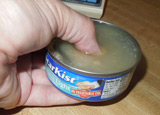How Much is Inside A Car Wash?
How Much Water Does it Take to Wash Your Car in the Driveway?
By Rob Cockerham |
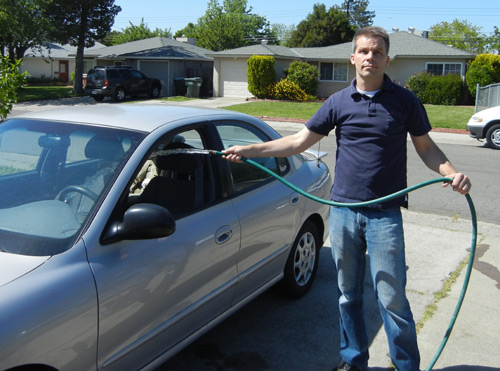
In California, and other places, water is precious. Sort of. It's precious in a "use as much as you want, but we recommend that you don't waste it" kind of way.
When the water supply gets tight, one of the first changes enacted is a ban on washing cars at home.
But how much water does that save? On Tuesday, we decided to find out.
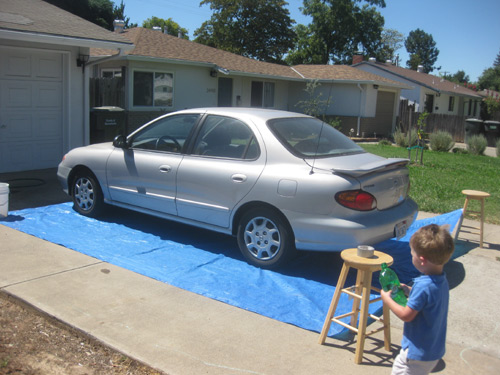
The first step was to spread out a plastic sheet under the car.
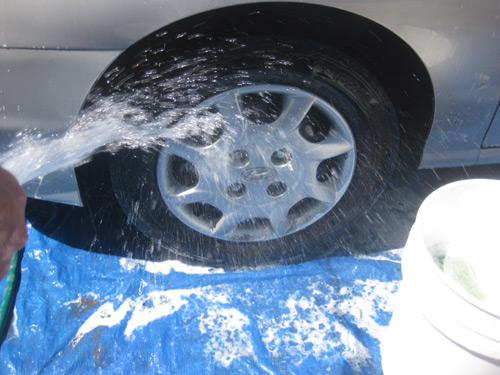
This would catch the water we were using, allowing us to measure the total number of gallons used to wash the car.
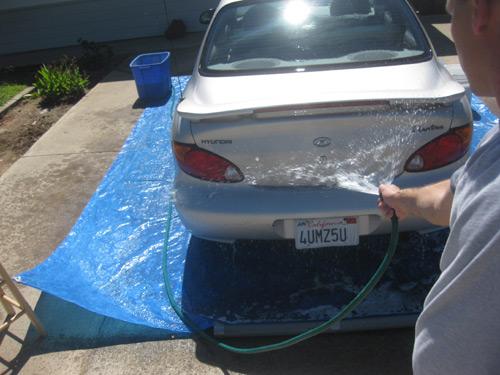
I washed and rinsed the car, and the blue tarp caught the runoff.

Unfortunately, neither my plan or my tarp were water tight.
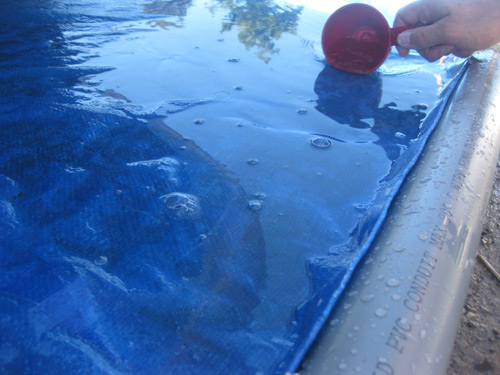
Apparently tarps are designed to repel raindrops, not for building pools.
I captured 10.5 gallons of water, but lost a stream that ran down into the gutter, ruining my total.

The only thing I learned was that I had used at least 10.5 gallons.
To capture 100% of the water I needed a water-tight car aquarium...or a new plan.
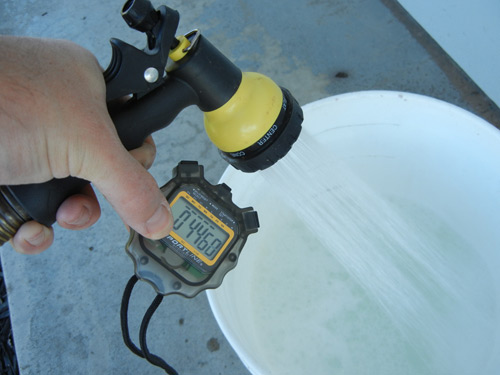
For the second trial, I ditched the idea of catching and measuring the runoff. The new plan was to calculate the water use from the source. I'd measure both the rate of flow and the total time of water spray.
I realized that it would be easy to time the rate of flow from the spray nozzle, and then use a stopwatch to keep track of how long I used the sprayer while I washed the car.
For this experiment, my water was on "full".
To check the rate of flow, I filled a graduated bucket to the five gallon mark. According to my stopwatch, this took 1 minute and 29 seconds, revealing a flow of 3.37 gallons per minute (202 GPH).
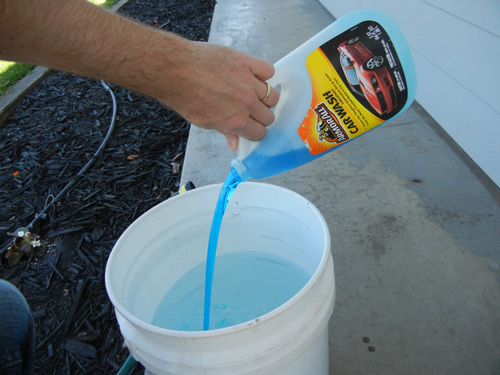
Next, I prepared to wash the car. I usually fill the bucket to around the three-gallon mark, and then add soap.
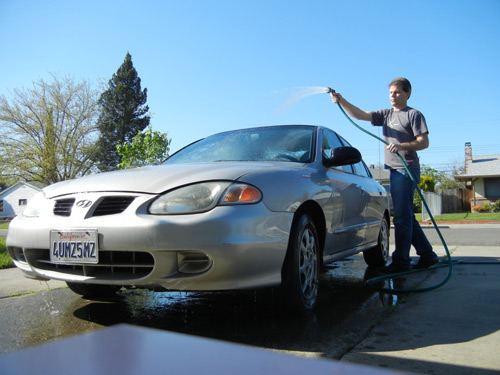
Here are the steps I follow when washing a car:
- fill the wash bucket
- get the car wet
- wash with sponge
- rinse car
- touch-up wash
- rinse car again
- dry

I timed step 2, getting the car wet.
This required 1 minute, 54 seconds, using 6.4 gallons of water.
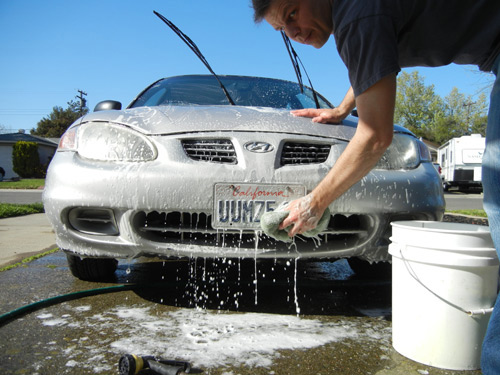
Next, I washed the car with a sponge. This took about 7 minutes.
Because I was using a trigger-activated spray gun, the water was off and I was not using any more water for this process. However, if I didn't have a spray gun, or any sense, I might leave the hose running during this period.
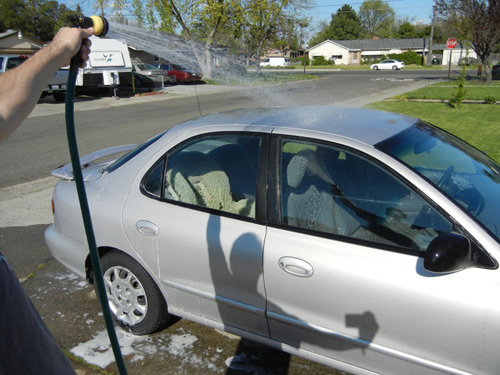
Step 4 is rinse the car, washing off the soap and dirt.
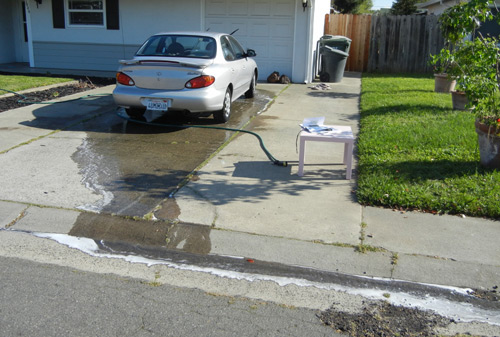
This required spraying for two minutes and 11 seconds, using 7.4 gallons of water.

Once the car was rinsed, I could see several areas which needed more cleaning. In a few places, the soap had dried in place, and didn't rinse clean. I began another round of cleaning, which I call the "touch-up wash" step. That took four minutes. Again, I wasn't using any water, but an idiot would let the hose run during this time, which would use a significant amount of water.

The sixth step is to rinse off the car again. This was a bit quicker than the first rinse, only taking 1 minute, 12 seconds and using four gallons of water. I paid special attention to the tires on this rinse.
The car was clean. I turned off the water and started drying the car with a towel.
Results:
I had four periods of water use: Filling the bucket, getting the car wet, the main rinse, and the touch-up rinse.
The bucket took three gallons. From the total time spent spraying (five minutes, 17 seconds), at a rate of 3.37 gallons per minute, I calculate a total spray volume of 17.8 gallons during the car wash.
Including the three gallon soap bucket, the car wash used a total of 20.8 gallons (77.8 liters) of water.
total of 20.8 gallons (77.8 liters) of water
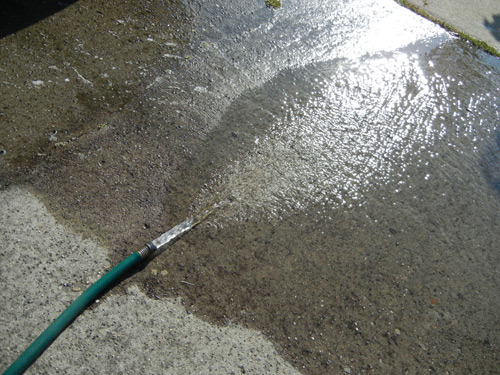
If I Hadn't Used a Spray Gun
As I mentioned above, if I did not have a spray nozzle on my hose, I would probably use more water while washing my car.
Without the restrictive nozzle of the spray gun, the hose emits three times as much water. It dumps five gallons in just 33 seconds, or 9.1 gallons per minute (546 GPH). Spraying the car for five minutes, 17 seconds at that rate would use 48 gallons of water. Rinses would probably be quicker if the hose was putting out that much water, but not 66% quicker. You still have to walk around the car and aim the spray.
Another consequence of using a hose without a nozzle is that the water might keep flowing during the washing steps of the car wash. For example, my main wash took eight minutes, and the follow up wash took another 4 minutes. Left flowing onto the driveway, the unrestricted hose would dump 109 gallons of water during that time.
Today I learned that washing your car in the driveway takes about 21 gallons of water. Is that a waste of 21 gallons? I don't think so, unless it happens to be the only water you have to mix with your scotch.
Update!
Since posting this article, a few people have written asking for information about other car washes. An ex-car wash chemical supplier wrote in with some helpful details.
Enjoyed your carwash wasted water test. An automated carwash like a PDQ Laserwash 4000, uses 90 to 150 gallons of water for a single wash, with a reclaim system it uses about 35 to 50. To me, a conscious car owner will do better than an automated one and will use less dangerous chemicals. For your info I was a carwash specialist for a major chemical manufacturer and serviced national accounts in Canada. A PDQ Spectrawash will use much more, up to 3 to 5 times more water per wash. Total waste. The best is a hand carwash or yourself in the driveway.
Merci et bonne journée
Thanks and have a nice day
Alain Dumas


